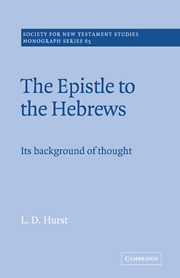Conclusion
Published online by Cambridge University Press: 20 November 2009
Summary
Our analysis of possible backgrounds of Hebrews has yielded negative and positive results. On the negative side, attempts to locate Auctor's center of gravity in Philo, Qumran, gnosticism, the Samaritans or Merkabah mysticism presented difficulties which outweighed any advantages. At one or two points (e.g., a “spiritualized” heavenly cultus) some form of modified Philonic influence could be said to be a possibility. But those emphases could equally be explained by influences within the apocalyptic tradition, and other indications suggest that this is the direction that future study should take in the effort to uncover first-century parallels for Hebrews.
On the positive side, surprisingly productive insights may be gained if William Manson's theory for Acts 7 and Hebrews is applied with sympathy and a bit of caution. A similar use of several of the same OT traditions, often clustered very closely in both writings, seems to point to some kind of contact between the two traditions. The exact form of that contact should constitute a focus of future study. The speech of Stephen, on the other hand, cannot be said to constitute the whole answer to the question of from where the author derived his use of OT traditions. Pauline theology must be considered somewhere in the process.
- Type
- Chapter
- Information
- The Epistle to the HebrewsIts Background of Thought, pp. 131 - 133Publisher: Cambridge University PressPrint publication year: 1990



